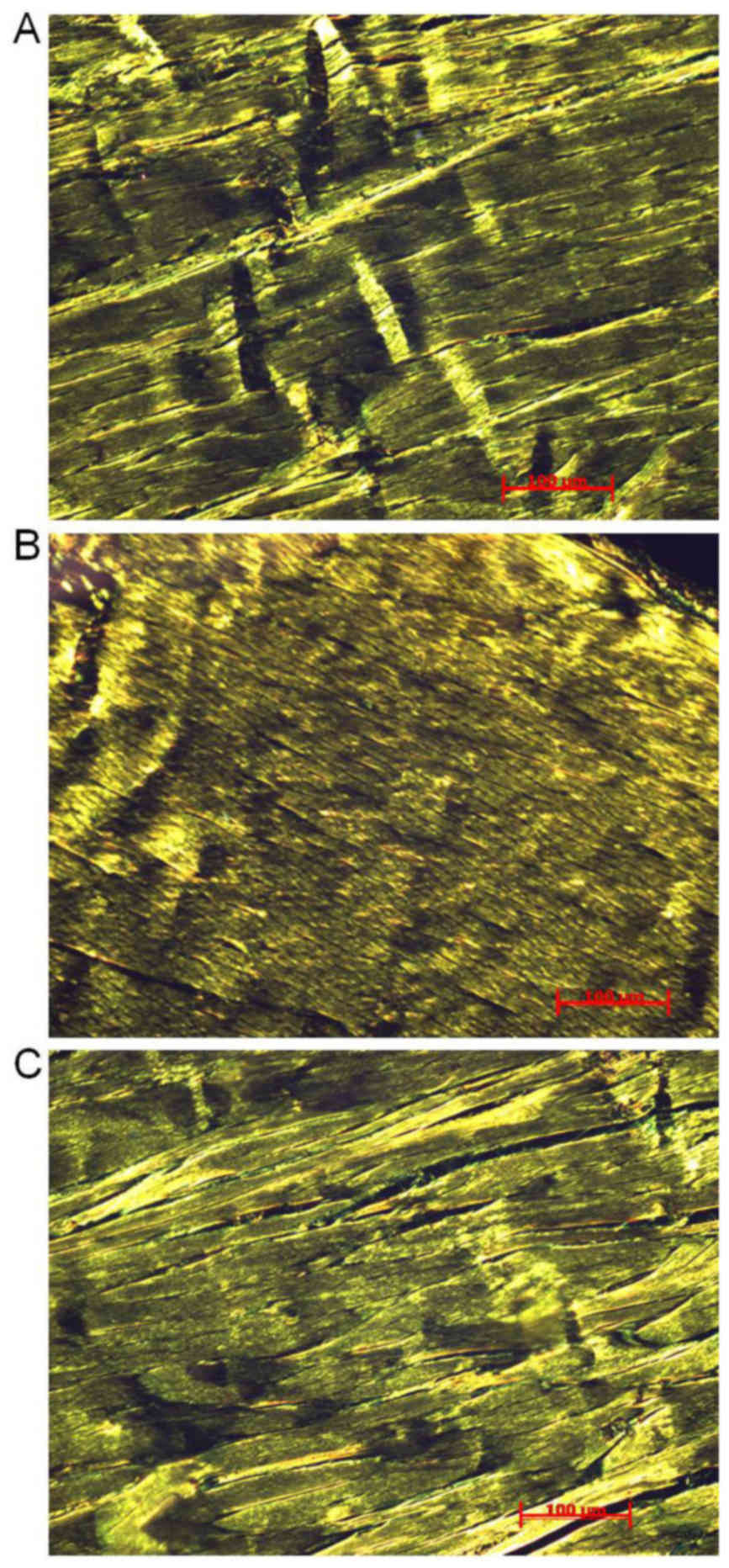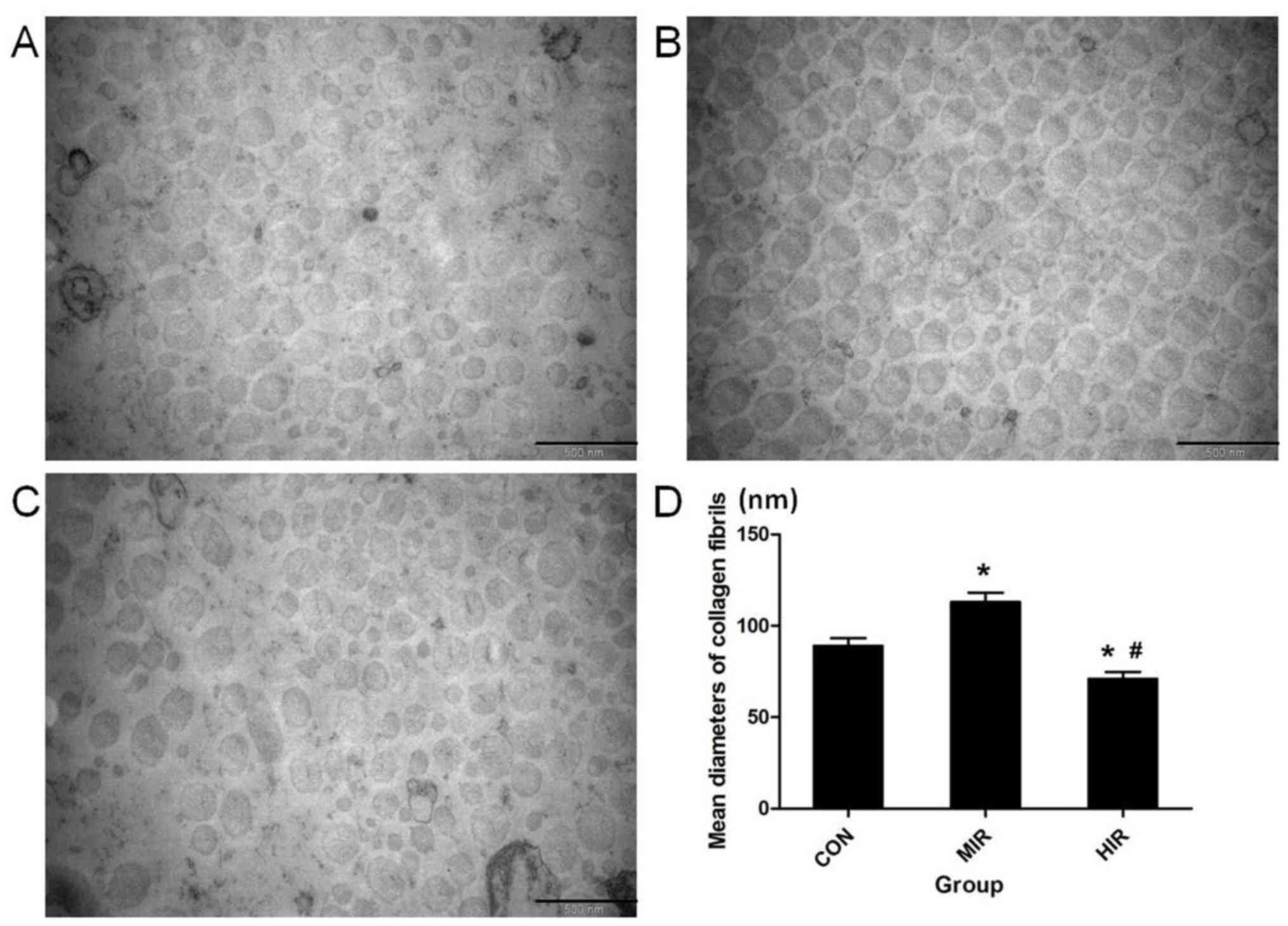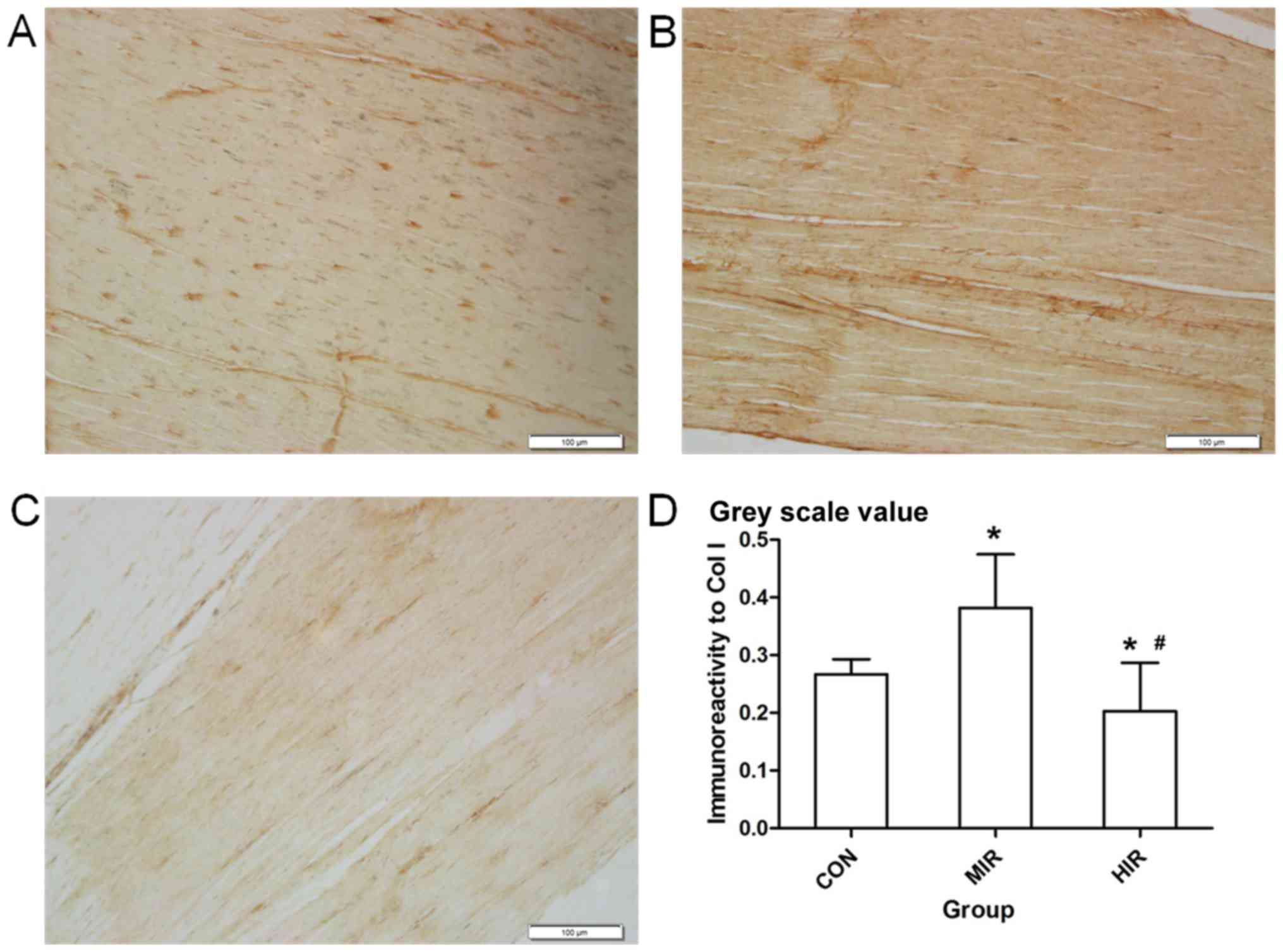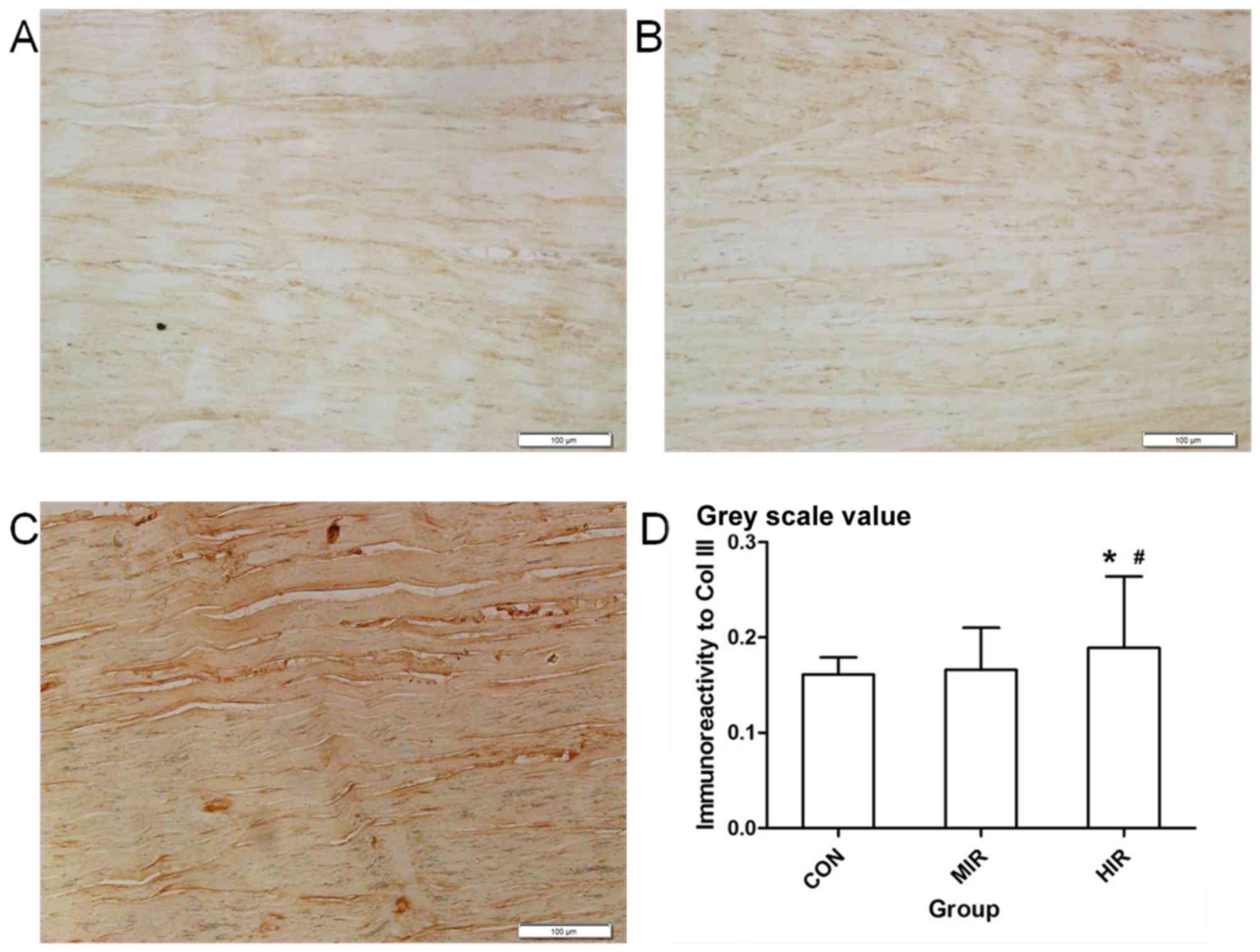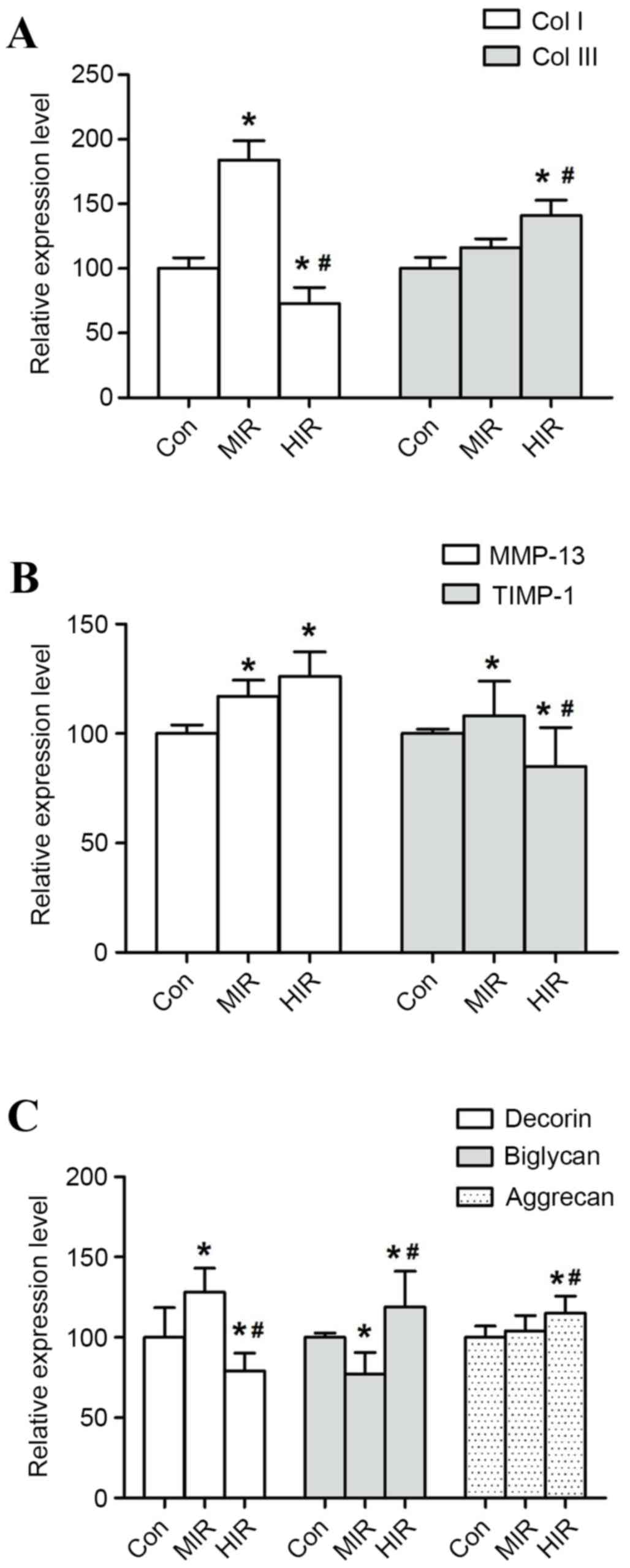Intensity‑dependent effect of treadmill running on rat Achilles tendon
- Authors:
- Published online on: April 20, 2018 https://doi.org/10.3892/etm.2018.6084
- Pages: 5377-5383
Abstract
Introduction
The primary function of a tendon is to transmit a mechanical force to move and stabilize joints (1). A tendon is characterized by a relatively small number of tenocyte cells and an extensive extracellular matrix (ECM), which includes collagens, proteoglycans (PGs), glycoproteins and water (2). Its dry mass is composed of ~86% collagen, 1–5% PGs and 0.2% inorganic components (3).
In normal tendons, ~90% of collagen is collagen type I (Col I) and the second most abundant is collagen type III (Col III) (4). Col I fibers are predominant structural components with dense, parallel arrays, and are regarded as major contributors in the transmission of mechanical force (5). The proportion and structure of collagen fibrils are crucial for the function of tendons and changes to the structure or proportion may result in adaptation or injury (6). Collagen molecules are produced by tenocytes, and are subsequently aggregated end-to-end and side-to-side to produce collagen fibrils (3). During this self-assembly process, the diameter, length and organization of collagen fibrils is regulated by PGs (7). Decorin, biglycan and aggrecan are regarded as the principal PGs in tendons (8). Subsequently, collagen fibrils, organized into fibers, bundles, and fascicles, provide tendons with structural integrity and mechanical function (9).
As tendons transmit mechanical force, tenocytes are able to detect and convert mechanical signals through mechanotransduction mechanisms into cellular biological events, such as the synthesis and degradation of collagen (10). The tenocytes also secrete matrix metalloproteinases (MMPs) and tissue inhibitor of metalloproteinases (TIMPs) (10). Previous studies have indicated that a balance of MMPs and TIMPs regulates collagen synthesis and that an imbalance may result in collagen degradation (11,12). Tsai et al (13) demonstrated that MMP-1 serves a major role in the degradation of Col I. MMP-1 is the predominant interstitial collagenase in humans; however, MMP-13 is predominant in rodents (14). TIMP-1 inhibits the MMP-mediated break-down of collagen matrix (15).
Furthermore, there is a vast difference in cellular biological responses to mechanical loading conditions according to the type, magnitude, frequency and intensity of these conditions (16,17). Regarding intensity, it is recognized that moderate mechanical loading may induce positive effects on tendons, whereas strenuous mechanical loading may lead to injury (18). Despite essential progress in the field, the effect of different mechanical loading conditions on tendons remains undefined (19). The purpose of the present study was to investigate the effect of different exercise intensity, characterized by very distinct loading patterns, using treadmill running to assess the alternations of collagens, PGs, MMP-13 and TIMP-1 in the ECM of rat Achilles tendons, in order to gain insights to evaluate tendon patho-physiology.
Materials and methods
Experimental animals and exercise protocols
A total of 18 male Wistar rats (12–13 weeks old; weight, 200–250 g) were purchased from the Central Laboratory of Animal Science, Southern Medical University (Guangzhou, China) (NFYY-2012-056). These rats were randomly and evenly assigned to one of three groups as follows: i) sedentary control (CON, n=6), ii) medium-intensity running (MIR, n=6) and iii) high-intensity running (HIR, n=6). All animals were housed in cages with a controlled humidity (40–60%) and temperature (22±1°C) under a 12h light/dark cycle, with ad libitum access to food and water. The protocol used in the present study was approved by the animal Ethics Committee of Nanfang Hospital, Southern Medical University (Guangzhou, China). The employed running protocol was described previously (20). Briefly, rats in the MIR and HIR groups were acclimatized to exercise for 1 week, which consisted of running on a treadmill at a speed of 10 m/min for 30 min/day, 5 days/week. Subsequently, animals in the MIR and HIR groups were regularly trained for 8 weeks as described in Table I. Rats in the CON group were maintained in cages without any additional exercise. All experiments were conducted in accordance with the institutional guidelines for the care and use of experimental animals (20). At the end of the 8-week running program, all rats were sacrificed via carbon dioxide asphyxiation (flow rate: 30% volume/min) followed by cervical dislocation. Subsequently, Achilles tendon tissues were surgically excised and harvested from all rats.
Table I.Treadmill running protocols for rats in the MIR and HIR groups, (n=6). Completed 5 days a week for 8 weeks. |
Picrosirius red staining
Achilles tendon tissues from each group were obtained by surgery excision for histological staining, fixed in 10% buffered formalin (4°C, overnight) and embedded in paraffin. Samples were cut into 4-mm thick sections, deparaffinized and stained with 5% Picrosirius red to highlight collagen fiber structure and improve its natural birefringence under a polarized light microscope at a magnification ×20 (Axioskop 40 Pol; Carl Zeiss AG, Oberkochen, Germany).
Immunohistochemistry
Immunohistochemistry for Col I and Col III was performed as previously described (6). Briefly, Achilles tendon tissues were decalcified with 9% formic acid for 10 min, washed with PBS for 1 min and embedded in paraffin. Then, 4-mm thick sections were cut and deparaffinized with xylene and different concentrations of ethanol (100, 95, 85 and 70%). Endogenous peroxidase activity was quenched with 3% hydrogen peroxide for 20 min at room temperature. Antigen retrieval was performed with citric acid (pH 6.0) using a high pressure method (21). The citric acid buffer was preheated for 5 min in an autoclave and sections were boiled for 2 min, followed by cooling for 20 min. Sections were blocked with 5% normal bovine serum albumin (BSA; Merck KGaA, Darmstadt, Germany) for 20 min at room temperature and sections were incubated with specific primary antibodies at 4°C overnight. The mouse anti-rat primary antibodies anti-Col I (cat. no. ab6308) and anti-Col III (cat. no. ab6310) were diluted by 1:100 (Abcam, Cambridge, UK). Sections were subsequently incubated with horseradish peroxidase conjugated goat anti-mouse Imunoglobulin G (1:200; cat. no. sc2005; Santa Cruz Biotechnology, CA, USA) for 1 h at room temperature, developed with 3,3′-Diaminobenzidine tetrahydrochloride (DAKO; Agilent Technologies, Inc., Santa Clara, CA, USA) and counter-stained in hematoxylin. The primary antibody was replaced with 5% BSA at 4°C overnight in the controls. To enable reproducibility and comparability, all incubation times and conditions were strictly controlled. The sections were examined under a color video camera attached to a H600L light microscope and image analysis system (Nikon Corporation, Tokyo, Japan). Images were captured using Image-Pro Plus version 6.0 software (Media Cybernetics, Inc., Rockville, MD, USA).
Transmission electron microscopy observation
Transmission electron microscopy (TEM) was completed as previously described (22). Achilles tendon tissues for TEM were fixed with 2.5% glutaraldehyde/4% formaldehyde fixative for 2 h at 4°C, post-fixed with 1% osmium tetroxide for 2 h, dehydrated with ethanol (50, 70, 90 and 100%; 20 min each step), embedded in Epon 812 and polymerized at 60°C. Ultrathin (50–60 nm) cross-sections were observed at 60 kV using a 7500 transmission electron microscope (Hitachi, Ltd., Tokyo, Japan) and digital images were captured at a magnification, ×60,000 with a Megaview III digital camera (Olympus Soft Imaging Solutions GmbH, Münster, Germany). A total of 500 collagen fibrils in each group were randomly selected and diameters were measured using Scion Image 4.0 Software (Scion Corporation, Frederick, MD, USA).
Reverse transcription-quantitative polymerase chain reaction (RT-qPCR)
Achilles tendon tissues for RT-qPCR were frozen in liquid nitrogen and broken into pieces with a pestle and mortar. Subsequently, the fragments were mixed and placed in a vessel containing 1 ml RNAiso Plus (Takara Biotechnology Co., Ltd., Dalian, China), followed by centrifugation at 13,362 × g for 15 min at 4°C. Prior to mixing, 0.2 ml chloroform (analytical pure) was added. The supernatant was removed following centrifugation at 13,362 × g for 15 min at 4°C, 500 ml isopropanol was added and the samples were once again centrifuged at 13,362 × g for 15 min at 4°C. The supernatant was discarded; 75% ethanol and 500 ml diethyl pyrocarbonate (DEPC)-treated H2O were added. The samples were centrifuged at 4,547 × g for 5 min at 4°C. The supernatant was discarded and the pellet was air dried. Subsequently, 30 µl of DEPC-treated H2O was added. Reverse transcription of the mRNA to template cDNA was completed using a PrimeScript RT reagent kit (Takara Biotechnology Co., Ltd.). The enzyme mix and RT primer mix were added to the mRNA sample and cDNA was generated by heating at 37°C for 15 min and 85°C for 5 sec. Quantitative PCR was performed using a 7500 Fast Real-Time PCR system (Applied Biosystems; Thermo Fisher Scientific, Inc., Waltham, MA, USA) and a SYBR Premix Ex Taq II kit (Takara Biotechnology Co., Ltd.); glyceraldehyde-3-phosphate dehydrogenase (GAPDH) was used as an endogenous reference and each sample was normalized to its GAPDH content. The PCR protocol used was as follows: 10 min heating at 95°C, followed by 45 cycles at 95°C for 10 sec, 55°C for 15 sec, 72°C for 30 sec. The mRNA expression of collagen (Col I and Col III), principal PGs (decorin, biglycan and aggrecan), MMP-13 and TIMP-1 in the Achilles tendon were detected via PCR. The sequences of PCR primers pairs (BioTeke Corporation, Beijing, China) are presented in Table II. The relative gene expression was calculated using the 2−ΔΔCT method (23). The assay was replicated in triplicate.
Statistical methods
Results are expressed as the mean ± standard deviation. Statistical analysis was carried out using one-way analysis of variance and Tukey's test for post hoc analysis. Data analysis was performed using SPSS 16.0 (SPSS, Inc., Chicago, IL, USA) and P<0.05 was considered to indicate a statistically significant difference.
Results
Picrosirius red staining
Following 8 weeks of treadmill running programs, Achilles tendons sections were stained with Picrosirius red to observe structural features of collagen fibrils using a polarized light microscope. Fig. 1 presents observed structural features in the three groups. Collagen fibers were organized in parallel with crimps in the CON group (Fig. 1A). Regularly and densely organized collagen fibrils were recorded in the MIR group (Fig. 1B). However, irregular and loosely organized collagen fibrils were observed in the HIR group (Fig. 1C).
TEM
Representative TEM images of the collagen fibrils in Achilles tendons in transverse section for each group are presented in Fig. 2; CON (Fig. 2A), MIR (Fig. 2B) and HIR (Fig. 2C). The diameter of collagen fibrils was calculated using Scion Image Software (Fig. 2D). Significantly thicker collagen fibrils were observed in the MIR group (113±5.2 nm) compared with the CON group (89±4.3 nm; P<0.05). Furthermore, significantly thinner collagen fibrils were observed in the HIR group (71±3.8 nm) compared with the CON and MIR groups (P<0.05).
Immunohistochemistry
Fig. 3 presents representative immunostaining of Col I in Achilles tendon sections in the CON (Fig. 3A), MIR (Fig. 3B) and HIR (Fig. 3C) groups. Immunohistological analysis for Col I was performed using Image-Pro Plus 6.0 software and is presented in Fig. 3D. The Col I content (image gray value) was significantly higher in the MIR group (0.382±0.093) compared with the CON group (0.267±0.026; P<0.05) and was significantly lower in the HIR group (0.203±0.084) compared with the CON or MIR groups (P<0.05).
Representative immunostaining of Col III in Achilles tendon sections is presented for each group in Fig. 4; CON (Fig. 4A), MIR (Fig. 4B) and HIR (Fig. 4C). Immunohistological analysis for Col III was completed using Image-Pro Plus 6.0 software (Fig. 4D). The Col III content (image gray value) was significantly higher in the HIR group (0.189±0.075) compared with the CON (0.161±0.018) or MIR (0.166±0.044; P<0.05) groups. No significant difference was observed between the CON and MIR groups.
RT-qPCR
Changes in the mRNA gene expression in rat Achilles tendons in CON, MIR and HIR groups is presented in Fig. 5. The expression of Col I was significantly upregulated in the MIR group compared with the CON group (P=0.024; Fig. 5A). However, Col I expression was significantly downregulated in the HIR group compared with the CON or MIR groups (P=0.037 and P=0.019, respectively; Fig. 5A). The expression of Col III was significantly upregulated in the HIR group when compared with the CON or MIR group (P=0.024, P=0.047, respectively; Fig. 5A). The changes in Col III mRNA gene expression were less pronounced in the MIR group in comparison with the CON group (P=0.196; Fig. 5A).
The expression of MMP-13 was significantly increased in the MIR and HIR groups in comparison with the CON group (P=0.028, P=0.013, respectively; Fig. 5B). However, a less pronounced change of MMP-13 mRNA expression was recorded in the HIR group in comparison with the MIR group (P=0.075; Fig. 5B). The expression of TIMP-1 was increased in the MIR group compared with the CON group (P=0.018; Fig. 5B), but significantly decreased in the HIR group compared with the CON or MIR groups (P=0.033, P=0.027, respectively).
Additionally, decorin expression was significantly higher in MIR group than that in CON group (P=0.034), whereas it was significantly lower in HIR group compared with the CON or MIR groups (P=0.039, P=0.032, respectively; Fig. 5C). Conversely, biglycan expression was significantly lower in MIR group than in the CON group (P=0.022), while significantly higher in the HIR group compared with the CON or MIR groups (P=0.038, P=0.027, respectively; Fig. 5C). Aggrecan expression was significantly higher in the HIR group compared with the CON or MIR groups (P=0.017, P=0.013, respectively). The change in mRNA gene expression of aggrecan was less significant in the MIR group in comparison with the CON group (P=0.073; Fig. 5C).
Discussion
In the present study, a running treadmill model at different speeds and inclinations was used to represent distinct exercise intensity and differentiate moderate and strenuous exercise. The results of the current study indicate that the crucial component, Col I was significantly increased in the MIR group compared with that in CON group (P<0.05). However, Col I was significantly decreased in the HIR group compared with the CON or MIR groups (P<0.05). Therefore demonstrating that synthesis or degradation of Col I occurred following 8 weeks of treadmill running. To evaluate the metabolism of collagen, the expression of MMP-13 and TIMP-1 was examined. Data from the present study indicated that the expression of MMP-13 and TIMP-1 was significantly increased in the MIR group (P<0.05). However, the expression of MMP-13 increased and the expression of TIMP-1 decreased in the HIR group. The aforementioned results suggested that MMP-13 and TIMP-1 were balanced and collagen synthesis occurred following MIR, but were imbalanced following HIR, which may lead to collagen degradation. These findings suggest that moderate exercise induced a balanced expression of MMPs and TIMPs, allowing collagen synthesis to improve mechanical strength for transmission. However, strenuous exercise induced an imbalance, leading to collagen degradation which may weaken mechanical strength and increase the risk of damage (24).
In addition, it should be noted that the level of Col III was increased in the HIR group. Col III has been reported to intercalate into the Col I fibrils and produce smaller, less organized fibrils (24). It was also regarded as an immature collagenous matrix (25). This may in accordance with the results of TEM in the present study, in which more mature and large diameter fibrils were observed in the MIR group but in the HIR group more immature and small diameter fibrils were observed (Fig. 2).
It has been indicated that PGs serve a vital role in the self-assembly process of collagen fibrils (26). The results of the present study revealed that decorin expression was higher in the MIR group and lower in the HIR group. This supports the observations made following Picrosirius red staining, in which regular collagen fibril arrangement in the MIR group was observed, whereas irregular arrangement was observed in the HIR group. Decorin has been reported to regulate the fibril diameter and help organize and orientate the collagen fibrils in tendons (27). However, a converse pattern of changes was identified in biglycan expression among the three groups. This is potentially due to high homology and co-expression of biglycan and decorin (28). Therefore, they may share common functions and partially compensate for each other's functions. Additionally, the findings of the current study indicated that aggrecan expression was higher in the HIR group. Aggrecan is located between adjacent collagen fiber bundles and increases the tendon hydration and fibril separation (29). This may explain the presence of more spaces between and in collagen fibril bundles observed in the HIR group.
However, the present study was limited by the use of only one time point (8 weeks) and the difference between rodent and human MMP expression. In addition, the alterations of a number of major molecules in ECM were observed, while other molecules may change and serve important roles in tendon patho-physiology.
In conclusion, the current study demonstrated a significant intensity-specific effect following treadmill running on the rat Achilles tendon. These results suggest that moderate exercise may induce increased collagen synthesis and organize regular and large collagen fibers, thus benefiting the Achilles tendon. Nevertheless, overuse may result in collagen degradation and disturbance, which is predisposed to injury. However, further studies with more time points and time frames should be completed to validate the findings.
Acknowledgements
The authors of the present study gratefully acknowledge Mr PR Zhao for technical assistance. The current study was supported by Natural Science Foundation of China (grant no. 81371686 and 81572219) and Guangdong Natural Science Foundation (grant no. S20140006946).
Competing interests
The authors declare that they have no competing interests.
References
|
Lin TW, Cardenas L and Soslowsky LJ: Biomechanics of tendon injury and repair. J Biomech. 37:865–877. 2004. View Article : Google Scholar : PubMed/NCBI | |
|
Heinemeier KM and Kjaer M: In vivo investigation of tendon responses to mechanical loading. J Musculoskelet Neuronal Interact. 11:115–123. 2011.PubMed/NCBI | |
|
Juneja SC and Veillette C: Defects in tendon, ligament, and enthesis in response to genetic alterations in key proteoglycans and glycoproteins: A review. Arthritis. 2013:1548122013. View Article : Google Scholar : PubMed/NCBI | |
|
Amiel D, Frank C, Harwood F, Fronek J and Akeson W: Tendons and ligaments: A morphological and biochemical comparison. J Orthop Res. 1:257–265. 1984. View Article : Google Scholar : PubMed/NCBI | |
|
Franchi M, Torricelli P, Giavaresi G and Fini M: Role of moderate exercising on Achilles tendon collagen crimping patterns and proteoglycans. Connect Tissue Res. 54:267–274. 2013. View Article : Google Scholar : PubMed/NCBI | |
|
Lui PP, Chan LS, Lee YW, Fu SC and Chan KM: Sustained expression of proteoglycans and collagen type III/type I ratio in a calcified tendinopathy model. Rheumatology (Oxford). 49:231–239. 2010. View Article : Google Scholar : PubMed/NCBI | |
|
Reese SP, Underwood CJ and Weiss JA: Effects of decorin proteoglycan on fibrillogenesis, ultrastructure, and mechanics of type I collagen gels. Matrix Biol. 32:414–423. 2013. View Article : Google Scholar : PubMed/NCBI | |
|
Rees SG, Flannery CR, Little CB, Hughes CE, Caterson B and Dent CM: Catabolism of aggrecan, decorin and biglycan in tendon. Biochem J. 350:181–188. 2000. View Article : Google Scholar : PubMed/NCBI | |
|
Wang JH: Mechanobiology of tendon. J Biomech. 39:1563–1582. 2006. View Article : Google Scholar : PubMed/NCBI | |
|
Wang JH, Thampatty BP, Lin JS and Im HJ: Mechanoregulation of gene expression in fibroblasts. Gene. 391:1–15. 2007. View Article : Google Scholar : PubMed/NCBI | |
|
Dalton S, Cawston TE, Riley GP, Bayley IJ and Hazleman BL: Human shoulder tendon biopsy samples in organ culture produce procollagenase and tissue inhibitor of metalloproteinases. Ann Rheum Dis. 54:571–577. 1995. View Article : Google Scholar : PubMed/NCBI | |
|
Thampatty BP, Li H, Im HJ and Wang JH: EP4 receptor regulates collagen type-I, MMP-1, and MMP-3 gene expression in human tendon fibroblasts in response to IL-1 beta treatment. Gene. 386:154–161. 2007. View Article : Google Scholar : PubMed/NCBI | |
|
Tsai WC, Hsu CC, Chang HN, Lin YC, Lin MS and Pang JH: Ibuprofen upregulates expressions of matrix metalloproteinase-1, −8, −9, and −13 without affecting expressions of types I and III collagen in tendon cells. J Orthop Res. 28:487–491. 2010.PubMed/NCBI | |
|
Wisløff U, Helgerud J, Kemi OJ and Ellingsen O: Intensity-controlled treadmill running in rats: VO(2 max) and cardiac hypertrophy. Am J Physiol Heart Circ Physiol. 280:H1301–H1310. 2001. View Article : Google Scholar : PubMed/NCBI | |
|
Brew K and Nagase H: The tissue inhibitors of metalloproteinases (TIMPs): An ancient family with structural and functional diversity. Biochim Biophys Acta. 1803:55–71. 2010. View Article : Google Scholar : PubMed/NCBI | |
|
Firth EC: The response of bone, articular cartilage and tendon to exercise in the horse. J Anat. 208:513–526. 2006. View Article : Google Scholar : PubMed/NCBI | |
|
Magnusson SP, Hansen P and Kjaer M: Tendon properties in relation to muscular activity and physical training. Scand J Med Sci Sports. 13:211–223. 2003. View Article : Google Scholar : PubMed/NCBI | |
|
Jhingan S, Perry M, O'Driscoll G, Lewin C, Teatino R, Malliaras P, Maffulli N and Morrissey D: Thicker Achilles tendons are a risk factor to develop Achilles tendinopathy in elite professional soccer players. Muscles Ligaments Tendons J. 1:51–56. 2011.PubMed/NCBI | |
|
Zhang J and Wang JH: The effects of mechanical loading on tendons-an in vivo and in vitro model study. PLoS One. 8:e717402013. View Article : Google Scholar : PubMed/NCBI | |
|
Ni GX, Liu SY, Lei L, Li Z, Zhou YZ and Zhan LQ: Intensity-dependent effect of treadmill running on knee articular cartilage in a rat model. Biomed Res Int. 2013:1723922013. View Article : Google Scholar : PubMed/NCBI | |
|
Norton AJ, Jordan S and Yeomans P: Brief, high-temperature heat denaturation (pressure cooking): A simple and effective method of antigen retrieval for routinely processed tissues. J pathol. 173:371–379. 1994. View Article : Google Scholar : PubMed/NCBI | |
|
Dunkman AA, Buckley MR, Mienaltowski MJ, Adams SM, Thomas SJ, Satchell L, Kumar A, Pathmanathan L, Beason DP, Iozzo RV, et al: The tendon injury response is influenced by decorin and biglycan. Ann Biomed Eng. 42:619–630. 2014. View Article : Google Scholar : PubMed/NCBI | |
|
Livak KJ and Schmittgen TD: Analysis of relative gene expression data using real-time quantitative PCR and the 2(-Delta Delta C(T)) method. Methods. 25:402–408. 2001. View Article : Google Scholar : PubMed/NCBI | |
|
Tan SC and Chan O: Achilles and patellar tendinopathy: Current understanding of pathophysiology and management. Disabil Rehabil. 30:1608–1615. 2008. View Article : Google Scholar : PubMed/NCBI | |
|
Fu SC, Wong YP, Cheuk YC, Lee KM and Chan KM: TGF-beta1 reverses the effects of matrix anchorage on the gene expression of decorin and procollagen type I in tendon fibroblasts. Clin Orthop Relat Res. 226–232. 2005. View Article : Google Scholar : PubMed/NCBI | |
|
Kalamajski S and Oldberg A: The role of small leucine-rich proteoglycans in collagen fibrillogenesis. Matrix Biol. 29:248–253. 2010. View Article : Google Scholar : PubMed/NCBI | |
|
Scott JE: Elasticity in extracellular matrix ‘shape modules’ of tendon, cartilage, etc. A sliding proteoglycan-filament model. J Physiol. 553:335–343. 2003. View Article : Google Scholar : PubMed/NCBI | |
|
Säämänen AM, Salminen HJ, Rantakokko AJ, Heinegård D and Vuorio EI: Murine fibromodulin: cDNA and genomic structure, and age-related expression and distribution in the knee joint. Biochem J. 355:577–585. 2001. View Article : Google Scholar : PubMed/NCBI | |
|
Smith MM, Sakurai G, Smith SM, Young AA, Melrose J, Stewart CM, Appleyard RC, Peterson JL, Gillies RM, Dart AJ, et al: Modulation of aggrecan and ADAMTS expression in ovine tendinopathy induced by altered strain. Arthritis Rheum. 58:1055–1066. 2008. View Article : Google Scholar : PubMed/NCBI |



